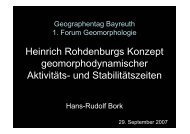Chapter 14 - Limitations on Predictive Modeling in Geomorphology ...
Chapter 14 - Limitations on Predictive Modeling in Geomorphology ...
Chapter 14 - Limitations on Predictive Modeling in Geomorphology ...
You also want an ePaper? Increase the reach of your titles
YUMPU automatically turns print PDFs into web optimized ePapers that Google loves.
LIMITATIONS ON PREDICTIVE MODELING 341<br />
Figure <str<strong>on</strong>g>14</str<strong>on</strong>g>.2 Sediment transport rate q s versus water discharge q for a sandy bed, based <strong>on</strong> several<br />
transport formulas: Shields (a), E<strong>in</strong>ste<strong>in</strong>-Brown (b) DuBoys (c), Engelund-Hansen (d), Blench (e),<br />
Laursen (f), Schoklitsch (g), Meyer-Peter (h). Based <strong>on</strong> <strong>in</strong>formati<strong>on</strong> compiled by the American<br />
Society of Civil Eng<strong>in</strong>eers (ASCE 1975)<br />
ago, scal<strong>in</strong>g up meant, at most, us<strong>in</strong>g local c<strong>on</strong>stitutive expressi<strong>on</strong>s of sediment discharge<br />
rates to predict total stream sediment discharge by multiply<strong>in</strong>g by the stream width (e.g.<br />
Graf 1971; ASCE 1975; Yal<strong>in</strong> 1977). Today, the calculati<strong>on</strong>al limitati<strong>on</strong> to<br />
upward-scal<strong>in</strong>g is be<strong>in</strong>g lifted as numerical simulati<strong>on</strong> approaches based <strong>on</strong> cell or grid<br />
methods (e.g. Tetzlaff and Harbaugh 1989) allow the <strong>in</strong>tegrati<strong>on</strong> of a large number of<br />
pieces of local <strong>in</strong>formati<strong>on</strong>. The simulati<strong>on</strong> studies menti<strong>on</strong>ed above of fans, dra<strong>in</strong>age<br />
networks, and other geomorphic features are direct c<strong>on</strong>sequences of this relaxati<strong>on</strong> of<br />
earlier c<strong>on</strong>stra<strong>in</strong>ts <strong>on</strong> model<strong>in</strong>g. An example <strong>in</strong> eng<strong>in</strong>eer<strong>in</strong>g is the impend<strong>in</strong>g replacement<br />
by the US Department of Agriculture of the Universal Soil Loss Equati<strong>on</strong> (Wischmeier<br />
1976) (a rat<strong>in</strong>g curve approach) as the basis for estimat<strong>in</strong>g potential erosi<strong>on</strong> <strong>on</strong> agricultural<br />
fields and rangelands. A detailed mechanistic, computer-based soil loss model, the<br />
Watershed Erosi<strong>on</strong> Predicti<strong>on</strong> Project (WEPP) (Lane et al. 1993) will be used <strong>in</strong>stead. The<br />
use of computer-based methods <strong>in</strong> attempts to predict the future behavior of sediment<br />
transport systems can be expected to c<strong>on</strong>t<strong>in</strong>ue to <strong>in</strong>crease. Potential limitati<strong>on</strong>s <strong>on</strong> the<br />
predictive power of such approaches, especially where l<strong>on</strong>g time scales are <strong>in</strong>volved, is<br />
the focus of this chapter.<br />
In mov<strong>in</strong>g from studies of sediment transport at small spatial scales and short time<br />
scales to large-scale geomorphic applicati<strong>on</strong>s, several sources of uncerta<strong>in</strong>ty or error arise<br />
that affect accuracy of predicti<strong>on</strong>. These uncerta<strong>in</strong>ties provide limits <strong>on</strong> how effectively








